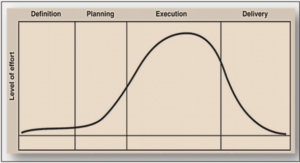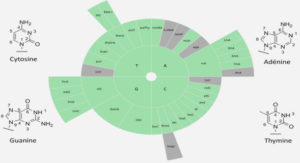Compromis entre reproduction immédiate et reproduction future dans un contexte de
compétition
Contexte de l’étude
Pour une femelle parasitoïde, un hôte peut aussi bien représenter une source de nourriture qu’une ressource de ponte. Par conséquent, lorsqu’une femelle se trouve confrontée à un hôte, elle a le choix entre pondre un œuf et ainsi investir dans la reproduction immédiate, se nourrir et investir dans la reproduction future ou bien les deux. Les parasitoïdes sont donc un modèle de choix pour l’étude des compromis entre reproduction immédiate et reproduction future. Si l’influence de l’état physiologique des femelles sur ce compromis est relativement bien étudiée et connue, tant d’un point de vue théorique qu’expérimental, l’impact de la qualité des hôtes l’est beaucoup moins. En 2004, Burger et al. ont montré chez Anisopteromalus calandrae, que les femelles choisissent préférentiellement des hôtes de grande taille pour pondre (ils sont considérés comme étant de bonne qualité pour le développement des larves) et des hôtes de petite taille pour se nourrir (ils seraient donc de moins bonne qualité). Un autre facteur impliqué dans la qualité d’un hôte est son statut parasité ou non. En effet, lorsque plusieurs individus sont pondus sur un même hôte, ils vont entrer en compétition. Cette compétition est d’autant plus importante chez les espèces solitaires, qu’elle s’exprime par des combats mortels entre les différentes larves. Ainsi, un hôte déjà parasité peut être considéré comme de faible qualité pour la ponte comparé à un hôte non parasité. D’un autre côté, hôtes parasités et non parasités n’apporteront pas forcément la même qualité de ressource nutritive. En effet, lors de la ponte, une femelle parasitoïde injecte généralement un venin. Ce venin peut engendrer différentes modifications physiologiques chez l’hôte, comme la paralysie de celui-ci ou bien des modifications de la composition de son hémolymphe. On observe parfois une augmentation de la concentration en lipides dans l’hémolymphe des hôtes après parasitisme (Rivers & Denlinger, 1995). Par conséquent, il est possible qu’un hôte parasité apporte plus de nutriments à une femelle qui lui ponctionne de l’hémolymphe. Dans cette partie, nous allons étudier l’influence du compromis entre reproductions immédiate et future sur la sélection d’hôtes parasités ou non parasités. Nous étudierons également comment l’état physiologique des femelles peut moduler ce choix (Article 1).
Introduction
In order to maximize lifetime reproductive success, females constantly need to balance their investment between laying eggs, i.e. in current reproduction, and searching for food, i.e. in future reproduction. In some cases, the same resource can have a reproductive and a nutritive value. Parasitoid females lay their eggs in or on hosts, and after hatching, larvae develop at the expense of hosts. Adult females can also feed directly on hosts by puncturing and consuming host haemolymph through a feeding tube (Giron et al., 2002). Feeding tubes are made by parasitoid females with secretion from their ovipositor inserted into the host (Fulton, 1933). A clear fluid flows from the ovipositor and congeals around it to form the feeding tube (Pupedis, 1978). The females then turn and use the feeding tube to extract the host haemolymph with their mouthpart (Giron et al., 2002). Depending on whether the host is used for feeding or for oviposition, parasitoid females obtain an immediate or a potential future fitness benefit. Host-feeding could provide adult females with nutritional resources to increase their life expectancy (Giron et al., 2002), egg maturation (Phillips, 1993; Ueno, 1999b; Burger et al., 2005; Rivero & West, 2005; Ferracini et al., 2006), or both (Collier, 1995; Heimpel et al.,1997; Giron et al., 2004). Host-feeding can be classified into different types: concurrent (when both host-feeding and oviposition occur on the same host), non-concurrent, destructive (when host-feeding kills the host and thus makes the host unsuitable for parasitoid development), and non-destructive (Jervis & Kidd, 1986; Krivan, 1997). Nonconcurrent/destructive and concurrent/non-destructive have been shown to be the feeding patterns which maximize parasitoid fitness (Krivan, 1997) and to be the most common in parasitoid species (Jervis & Kidd, 1986). An important feature of the trade-off between current and future reproduction is the quality of hosts encountered by females. They prefer to feed on hosts of poor quality for larval development, while saving hosts of higher quality for oviposition and offspring development (Burger et al., 2004). Anisopteromalus calandrae females tend to choose large hosts for oviposition and small hosts for feeding (Choi et al., 2001). Another host quality predictor is the parasitized status of the host, already parasitized hosts usually being considered as lower quality for oviposition than unparasitized ones (Godfray, 1994). In solitary species, only one adult can emerge from a given host, whatever the number of eggs laid, due to lethal larval fights (Ueno, 1997; van Baaren et al., 1999). Thus, by laying an egg on a parasitized host, females reduce the survival rate of their progeny (Lebreton et al., 2009b). However, already parasitized hosts could be more profitable for feeding. In idiobiont species of pupal and larval parasitoids, females inject venom into the host before ovipositing or feeding, inducing the paralysis of the host and arresting its growth (Mackauer & Sequeira, 1993). Feeding on these paralyzed hosts could be advantageous for females because less time and energy are required. Moreover, the venom could induce changes in the haemolymph composition of the hosts (Cox, 1970), such as an increase in the amount of haemolymph lipids (Cox, 1970; Rivers & Denlinger, 1995; Nakamatsu & Tanaka, 2003). Feeding on already parasitized hosts could thus provide the females with an additional supply of nutrients. This aspect has never been investigated in studies dealing with the trade-off between current and future reproduction. However, several recent theoretical studies have investigated this trade-off (Collier et al., 1994; Heimpel et al., 1994; Sirot & Bernstein, 1996; Sirot & Bernstein, 1997; Burger et al., 2004). Overall, they indicate that the optimal strategies depend on both the physiological state of female parasitoids and host availability. According to this theory, female parasitoids give preference to host-feeding when they are young, when their egg load and their nutritional state are low and host availability is high (Heimpel et al., 1994). These theoretical models have been supported by experimental studies. For example, females of the parasitoid Aphytis melinus invest more in host-feeding than in oviposition when they have lower egg load and ewer nutritional reserves (Heimpel & Rosenheim, 1995). While the value allocated to hosts by parasitoid females depends on their strategy (feeding or egg-laying), host selection could be influenced by the females’ physiological state. The main purpose of this study was to investigate the trade-off between current and future reproduction in the solitary ectoparasitoid Anisopteromalus calandrae Howard (Hymenoptera, Chalcidoidea, Pteromalidae). We investigated whether females’ reproductive strategies (oviposition or feeding) were influenced by the host’s parasitized status (parasitized or unparasitized) and/or by their physiological state (age and diet). The cost and benefits of feeding according to host status are then discussed, in relation to the amount of nutrients available in host haemolymph.
Materials and methods
Rearing conditions
Anisopteromalus calandrae is a parasitoid of the larvae and pupae of the bruchid Callosobruchus maculatus (Coleoptera, Bruchidae) from the tropical zones of West Africa. Both C. maculatus and A. calandrae originated from Ivory Coast (collected in 2000) and were reared in the laboratory under conditions close to their area of origin: 12 h light at 30°C, 12 h dark at 22°C, and 71% r.h. General methods Anisopteromalus calandrae females were allowed to lay on an artificial seed system composed of gelatine capsules (Gauthier & Monge, 1999; Darrouzet et al., 2003). The bruchid L4 larvae were placed inside the capsules after removal from seeds by dissection. The size of larvae was homogenized to avoid a bias in the females’ strategy due to this factor. The gelatine capsules mimic the bruchid pupal chamber in the seed and are accepted for oviposition by females. To obtain parasitized hosts, five gelatine capsules each containing one C. maculatus L4 larva were offered to a group of ten virgin A. calandrae females confined to an arena (2.5 cm high × 8 cm in diameter). Hymenoptera parasitoids reproduce by arrhenotokous parthenogenesis, whereby fertilized (diploid) eggs develop into females and unfertilized (haploid) eggs into males. Thus, by using virgin females, only male eggs were obtained, thereby preventing a bias due to the sex of eggs presented to the females. The injection of A. calandrae venom induces the paralysis of C. maculatus larvae (Lebreton, personal observations). To ensure that females injected venom during oviposition, the Deuxième partie Compromis entre reproduction immédiate et future 53 paralyzed status of the parasitized hosts was controlled. These hosts were then used in choice tests. The survival rate of an egg laid on an already parasitized host decreases sharply with the time after the first parasitism event (Lebreton et al., 2009b). In order to avoid a bias due to these survival probability differences, hosts were only offered for two hours after oviposition; the survival rate of the second egg laid remains stable at about 50% during this time interval (Lebreton et al., 2009b). Preparation of experimental females To investigate the influence of the physiological state of mated females on their reproductive strategies, we looked at parameters of both age and nutritional state. Mated females were obtained by placing a 2-hour-old virgin female with a 24-hour-old virgin male in a Petri dish. Mating was confirmed by direct observation. Two age categories (3 days and 15 days old) of females were investigated. Under our laboratory conditions, less than 25% of females remain alive after 23 days (Do Thi Khanh et al., 2005); 15-day-old females could therefore be considered as old. Furthermore, A. calandrae is a synovigenic species, i.e. females emerge without mature eggs; the experiment therefore took place after three days to ensure that the young females were bearing mature eggs. These two categories of age were thus selected to compare the reproductive strategy of young and old females. Before the experiments, all the females were fed with a solution of sucrose replaced every two days. Three days before the beginning of the experiment one group of females in each age category was allowed to feed on C. maculatus larvae. In order to avoid a bias due to previous oviposition experience, the larvae offered to females were first removed from their seed, preventing the females from laying eggs on them, without stopping them from feeding (Lebreton, personal observation).





